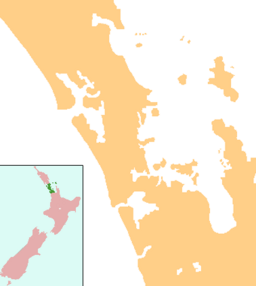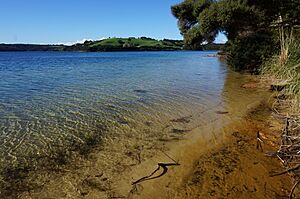Lake Rototoa facts for kids
Quick facts for kids Lake Rototoa |
|
|---|---|
 |
|
| Location | Auckland Region, North Island |
| Coordinates | 36°30′49″S 174°14′15″E / 36.5135°S 174.2375°E |
| Basin countries | New Zealand |
| Surface area | 1.39 km2 (0.54 sq mi) |
| Max. depth | 26 m (85 ft) |
Lake Rototoa is a beautiful lake located in the Auckland Region of New Zealand. It sits at the northern end of the south head of the Kaipara Harbour. This lake is special because it's the biggest and deepest of many lakes found along the western coast of the North Island.
Lake Rototoa covers an area of about 1.39 square kilometers. That's like 139 rugby fields! It's also quite deep, reaching down to 26 meters at its deepest point. Imagine stacking more than five double-decker buses on top of each other – that's how deep it is!
Contents
Discovering Lake Rototoa
Lake Rototoa is part of a group of lakes called sand-dune lakes. These lakes form in the hollows between sand dunes, often near coastlines. They are an important part of New Zealand's natural environment.
Where is Lake Rototoa?
The lake is found in the Rodney District, which is part of the wider Auckland Region. It's a peaceful spot, away from busy city life. Its location near the Kaipara Harbour makes it a unique part of the landscape.
The Story Behind the Name
The name of the lake has an interesting history. It was once known as Lake Ototoa. In 2013, its name was officially changed to Lake Rototoa.
What Does Rototoa Mean?
The name Rototoa comes from the Māori language. It means 'Lake of the Warrior'. This name connects the lake to important stories and history of the local Māori people.
The Footsteps of Kawharu
Lake Rototoa is also part of a series of lakes known as 'the Footsteps of Kawharu'. This name comes from a famous warrior named Kawharu. He was a leader of the Ngāti Whātua tribe.
Kawharu was known for his bravery and strength. He fought in battles during the late 1600s and early 1700s. These battles were against other tribes in the area, like the Waiohua, Ngaririki, and Kawerau. The lakes are named after his journey and the places where he fought. This story helps us understand the rich history of the land.



